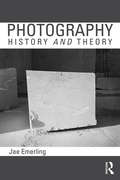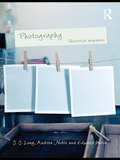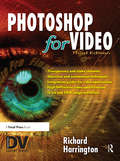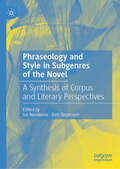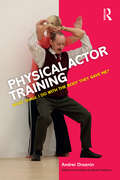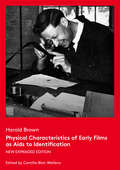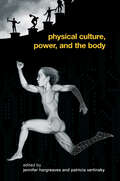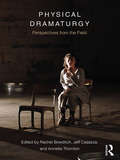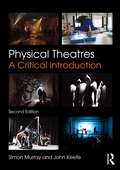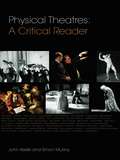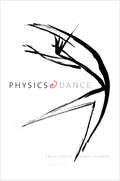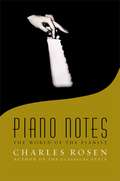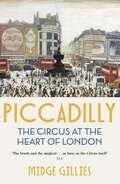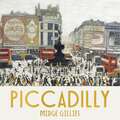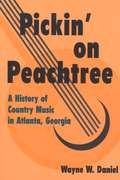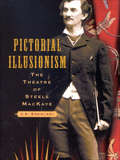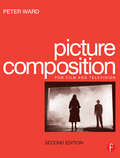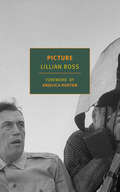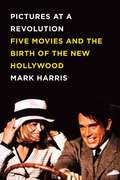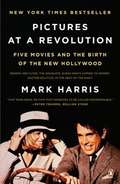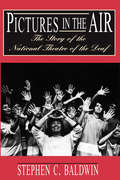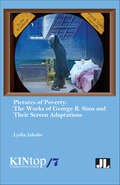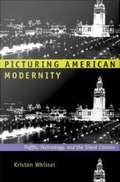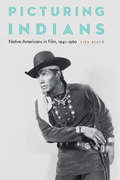- Table View
- List View
Photography: History And Theory
by Jae EmerlingPhotography: History and Theory introduces students to both the history of photography and critical theory. From its inception in the nineteenth century, photography has instigated a series of theoretical debates. In this new text, Jae Emerling therefore argues that the most insightful way to approach the histories of photography is to address simultaneously the key events of photographic history alongside the theoretical discourse that accompanied them. While the nineteenth century is discussed, the central focus of the text is on modern and contemporary photographic theory. Particular attention is paid to key thinkers, such as Baudelaire, Barthes and Sontag. In addition, the centrality of photography to contemporary art practice is addressed through the theoretical work of Allan Sekula, John Tagg, Rosalind Krauss, and Vilém Flusser. The text also includes readings of many canonical photographers and exhibitions including: Atget, Brassai, August Sander, Walker Evans, The Family of Man, Diane Arbus, Lee Friedlander, Cindy Sherman, Bernd and Hilla Becher, Sebastaio Salgado, Jeff Wall, and others. In addition, Emerling provides close readings of key passages from some major theoretical texts. These glosses come between the chapters and serve as a conceptual line that connects them. Glosses include: Roland Barthes, "The Rhetoric of the Image" (1964) Susan Sontag, Regarding the Pain of Others (2002) Michel Foucault on the archive (1969) Walter Benjamin, "Little History of Photography" (1931) Vilém Flusser, Towards a Philosophy of Photography (1983) A substantial glossary of critical terms and names, as well as an extensive bibliography, make this the ideal book for courses on the history and theory of photography.
Photography: Theoretical Snapshots
by J. J. Long Edward Welch Andrea NobleOver the past twenty-five years, photography has moved to centre-stage in the study of visual culture and has established itself in numerous disciplines. This trend has brought with it a diversification in approaches to the study of the photographic image. Photography: Theoretical Snapshots offers exciting perspectives on photography theory today from some of the world’s leading critics and theorists. It introduces new means of looking at photographs, with topics including: a community-based understanding of Spencer Tunick’s controversial installations the tactile and auditory dimensions of photographic viewing snapshot photography the use of photography in human rights discourse. Photography: Theoretical Snapshots also addresses the question of photography history, revisiting the work of some of the most influential theorists such as Roland Barthes, Walter Benjamin, and the October group, re-evaluating the neglected genre of the carte-de-visite photograph, and addressing photography’s wider role within the ideologies of modernity. The collection opens with an introduction by the editors, analyzing the trajectory of photography studies and theory over the past three decades and the ways in which the discipline has been constituted. Ranging from the most personal to the most dehumanized uses of photography, from the nineteenth century to the present day, from Latin America to Northern Europe, Photography: Theoretical Snapshots will be of value to all those interested in photography, visual culture, and cultural history.
Photoshop for Video
by Richard HarringtonMaster the graphic design and production skills required of today's video editors and motion graphic professionals with this comprehensive guide to the video tools in Adobe Photoshop CS3. Every page is filled with techniques to help the video professional make graphics for use in television, video, the Internet, and DVD. Lively discourse, full-color presentations, and hands-on tutorials demonstrate everything you need to know about how to combine still and moving images. Fundamental concepts such as transparency, pixel aspect ratio, and alpha channels are made precisely clear, and advanced techniques show how to use Photoshop as a character generator, color corrector, and animation tool.This edition features expanded coverage of DVD and motion graphics design, as well as addressing recent developments in High Definition video and 32-bit imaging. This indispensable reference includes:* real-world solutions for making graphics for video* introduction to third party plug-ins* automation and shortcut methods that cut production time* profiles of notable editors and motion graphic artists that include their favorite tips and tricksThe DVD offers a hands-on multimedia experience with hundreds of images to work on, tutorials to complete and 2 ½ hours of video training to watch.
Phraseology and Style in Subgenres of the Novel: A Synthesis of Corpus and Literary Perspectives
by Iva Novakova Dirk SiepmannThis edited book represents the first cohesive attempt to describe the literary genres of late-twentieth-century fiction in terms of lexico-grammatical patterns. Drawing on the PhraseoRom international project on the phraseology of contemporary novels, the contributed chapters combine literary studies with corpus linguistics to analyse fantasy, romance, crime, historical and science fiction in French and English. The authors offer new insights into long-standing debates on genre distinction and the hybridization of genres by deploying a new, interdisciplinary methodology. Sitting at the intersection of literature and linguistics, with a firm grounding in the digital humanities, this book will be of particular relevance to literary scholars, corpus stylists, contrastivists and lexicologists, as well as general readers with an interest in twentieth-century genre fiction.
Physical Actor Training: What Shall I Do with the Body They Gave Me?
by Andrei DrozninIf, as an actor, your body is your 'instrument' - and the only way you can express the internal impulses of the character you’re playing - what happens when the body-mind, ‘psychophysical’ connection is lost? Andrei Droznin, Russia's foremost teacher of physical actor training, calls this loss the 'desomatization' of the human body, and argues that these connections urgently need to be restored for full expressivity. This is a genuinely unique book which links theory to practice by a man who has worked at the very top of Russian theatre; a movement specialist who has taught at the Moscow Art Theatre as well as drama schools all over the world. Beautifully translated by Natasha Fedorova, this volume will excite and inspire a new generation of English-language readers.
Physical Characteristics of Early Films as Aids to Identification: New expanded Edition
by Camille Bolt-WellensAny archivists who have held a piece of fi lm in their hands, wondering how to go about identifying it, recognize the true value of fi lm preservationist Harold Brown's work. In 1967 Brown delivered a pioneering lecture on the identification of early films at the annual Congress of the International Federation of Film Archives (FIAF) in East Berlin. Years of working with Britain's National Film Archive collections, and the close examination of thousands of nitrate prints of the silent period, made Brown a leading authority on early fi lm identification, and an unsurpassed model of methodological consciousness in the archival field. In 1990, FIAF published Brown's Physical Characteristics of Early Films as Aids to Identification, an updated version and a continuation of his 1967 lecture. This publication has long been archivists' trusted companion, constituting a concentrated encyclopedia on all the information that can be discovered or verified through aspects of the fi lm other than the actual projected image – such as perforation shapes; embossed and punched marks; stock manufacturers' and producers' edge marks; frame characteristics; title styles; and production serial numbers. It also included essays on key individual production companies of the silent era. Over the last 30 years, this manual – a basic typewritten 100-page volume (including 20 pages of black & white illustrations), with its easily recognizable red cover – has been an invaluable reference for fi lm archivists and scholars. However, as Brown himself acknowledged in the 1990 edition, the manual was far from definitive. Camille Blot-Wellens, the editor of this new, expanded edition of Brown's 1990 book, belongs to the new generation of researchers who have used Physical Characteristics extensively in their work and have gathered considerable new information on the subject. This new edition is the result of a project she initiated in 2014 with FIAF's support. Brown's original text is now augmented with new original research on key fi lm manufacturers and producers by Camille Bolt-Wellens and other leading archivists and researchers in the field. Richly illustrated (the book contains over 900 images, including 125 in full color), this new 336-page edition of Harold Brown's seminal manual will be welcomed by many, and will no doubt become a must-have working tool for many in the fi lm archiving and academic fields.
Physical Culture, Power, and the Body (Routledge Critical Studies in Sport)
by Patricia Vertinsky Jennifer HargreavesDuring the past decade, there has been an outpouring of books on 'the body' in society, but none has focused as specifically on physical culture - that is, cultural practices such as sport and dance within which the moving physical body is central. Questions are raised about the character of the body, specifically the relation between the ‘natural’ body, the ‘constructed’ body and the ‘alien’ or ‘virtual’ body. The themes of the book are wide in scope, including: physical culture and the fascist body sport and the racialised body sport medicine, health and the culture of risk the female Muslim sporting body, power, and politics experiencing the disabled sporting body embodied exhibitions of striptease and sport the social logic of sparring sport, girls and the neoliberal body. Physical Culture, Power, and the Body aims to break down disciplinary boundaries in its theoretical approaches and its readership. The author’s muli-disciplinary backgrounds, demonstrate the widespread topicality of physical culture and the body.
Physical Dramaturgy: Perspectives from the Field
by Rachel Bowditch Jeff Casazza Annette ThorntonWhat is physical dramaturgy? While the traditional dramaturg shares research intellectually, the physical dramaturg does so viscerally and somatically. By combining elements of text, history, dramatic structure, and the author’s intent with movement analysis and physical theatre pedagogies, the physical dramaturg gives actors the opportunity to manifest their work in a connected and intuitive manner and creates a field that is as varied and rich as the theatre itself. Physical Dramaturgy: Perspectives from the Field explores the ways in which this unique role can benefit the production team during the design and rehearsal phases of both traditional and devised productions. Individual chapters look at new ways of approaching a wealth of physical worlds, from the works of Shakespeare and other period playwrights to the processes of Jerzy Grotowski, Lloyd Williamson, Richard Schechner, and Michael Chekhov, and devising original works in a variety of contexts from Pig Iron, Dell’Arte International, Bill Bowers and mime, Tectonic Theater Project, and Liz Lerman’s Dance Exchange. This anthology gives dramaturgs, actors, and directors new ways of looking at existing methods and provides examples of how to translate, combine, and adapt them into new explorations for training, rehearsal, or research.
Physical Theatres: A Critical Introduction
by Simon Murray John KeefeThis new edition of Physical Theatres: A Critical Introduction continues to provide an unparalleled overview of non-text-based theatre, from experimental dance to traditional mime. It synthesizes the history, theory and practice of physical theatres for students and performers in what is both a core area of study and a dynamic and innovative aspect of theatrical practice. This comprehensive book: traces the roots of physical performance in classical and popular theatrical traditions looks at the Dance Theatre of DV8, Pina Bausch, Liz Aggiss and Jérôme Bel examines the contemporary practice of companies such as Théatre du Soleil, Complicite and Goat Island focuses on principles and practices in actor training, with reference to figures such as Jacques Lecoq, Lev Dodin, Philippe Gaulier, Monika Pagneux, Etienne Decroux, Anne Bogart and Joan Littlewood. Extensive cross references ensure that Physical Theatres: A Critical Introduction can be used as a standalone text or together with its companion volume, Physical Theatres: A Critical Reader, to provide an invaluable introduction to the physical in theatre and performance. New to this edition: a chapter on The Body and Technology, exploring the impact of digital technologies on the portrayal, perception and reading of the theatre body, spanning from onstage technology to virtual realities and motion capture; additional profiles of Jerzy Grotowski, Wrights and Sites, Punchdrunk and Mike Pearson; focus on circus and aerial performance, new training practices, immersive and site-specific theatres, and the latest developments in neuroscience, especially as these impact on the place and role of the spectator.
Physical Theatres: A Critical Reader
by Simon Murray John KeefePhysical Theatres: A Critical Reader is an invaluable resource for students of physically orientated theatre and performance. This book aims to trace the roots and development of physicality in theatre by combining practical experience of the field with a strong historical and theoretical underpinning. In exploring the histories, cross-overs and intersections of physical theatres, this critical Reader provides: six new, specially commissioned essays, covering each of the book’s main themes, from technical traditions to contemporary practises discussion of issues such as the foregrounding of the body, training and performance processes, and the origins of theatre in both play and human cognition a focus on the relationship and tensions between the verbal and the physical in theatre contributions from Augusto Boal, Stephen Berkoff, Étienne Decroux, Bertolt Brecht, David George, J-J. Rousseau, Ana Sanchez Colberg, Michael Chekhov, Jeff Nuttall, Jacques Lecoq, Yoshi Oida, Mike Pearson, and Aristotle.
Physics and Dance
by Emily Coates Sarah DemersA fascinating exploration of our reality through the eyes of a physicist and a dancer—and an engaging introduction to both disciplines From stepping out of our beds each morning to admiring the stars at night, we live in a world of motion, energy, space, and time. How do we understand the phenomena that shape our experience? How do we make sense of our physical realities? Two guides—a former member of New York City Ballet, Emily Coates, and a CERN particle physicist, Sarah Demers—show us how their respective disciplines can help us to understand both the quotidian and the deepest questions about the universe. Requiring no previous knowledge of dance or physics, this introduction covers the fundamentals while revealing how a dialogue between art and science can enrich our appreciation of both. Readers will come away with a broad cultural knowledge of Newtonian to quantum mechanics and classical to contemporary dance. Including problem sets and choreographic exercises to solidify understanding, this book will be of interest to anyone curious about physics or dance.
Pianist's Progress
by Helen Drees RuttencutterIn Pianist's Progress, Helen Ruttencutter takes the reader behind the scenes in the fiercely competitive music world, vividly depicting a young musician's quest for a career. But ultimately her subject is the dynamics of training and grooming for success.
Piano Notes: The World of the Pianist
by Charles RosenCharles Rosen is one of the world's most talented pianists -- and one of music's most astute commentators. Known as a performer of Bach, Beethoven, Stravinsky, and Elliott Carter, he has also written highly acclaimed criticism for sophisticated students and professionals. In Piano Notes, he writes for a broader audience about an old friend -- the piano itself. Drawing upon a lifetime of wisdom and the accumulated lore of many great performers of the past, Rosen shows why the instrument demands such a stark combination of mental and physical prowess. Readers will gather many little-known insights -- from how pianists vary their posture, to how splicings and microphone placements can ruin recordings, to how the history of composition was dominated by the piano for two centuries. Stories of many great musicians abound. Rosen reveals Nadia Boulanger's favorite way to avoid commenting on the performances of her friends ("You know what I think," spoken with utmost earnestness), why Glenn Gould's recordings suffer from "double-strike" touches, and how even Vladimir Horowitz became enamored of splicing multiple performances into a single recording. Rosen's explanation of the piano's physical pleasures, demands, and discontents will delight and instruct anyone who has ever sat at a keyboard, as well as everyone who loves to listen to the instrument. In the end, he strikes a contemplative note. Western music was built around the piano from the classical era until recently, and for a good part of that time the instrument was an essential acquisition for every middle-class household. Music making was part of the fabric of social life. Yet those days have ended. Fewer people learn the instrument today. The rise of recorded music has homogenized performance styles and greatly reduced the frequency of public concerts. Music will undoubtedly survive, but will the supremely physical experience of playing the piano ever be the same?
Piccadilly: The Circus at the Heart of London
by Midge GilliesThere's nowhere quite like Piccadilly Circus.From the moment they emerge, blinking from the underground station, visitors to Piccadilly Circus face a sensory onslaught. Its streets and alleyways merge into an intoxicating thoroughfare, with the power to propel an individual onwards to adventure, romance, or something more sinister. Ever since its iconic Eros statue appeared in 1893, the junction has been a vibrant meeting place, attracting visitors and pleasure-seekers from all walks of life: political plans and theatrical careers were hatched at its restaurant and café tables, lovers met below the statue of Eros, and to this day tourists pour out of its historic Tube to experience the bright lights of London's nightlife.Piccadilly explores how the area has been shaped by social and historical events - from female suffrage to world wars to technological advancements - and by its colourful cast of characters - from flower girls, shop assistants and sex workers, to film stars, Bright Young Things and conmen (and women).For many, the Circus has represented both a home from home and a brave new world, as campaigners, revellers, opportunists and romantics have all been drawn to Piccadilly's bright lights. This is the story of why Piccadilly Circus continues to mean so much to so many.
Piccadilly: The Circus at the Heart of London
by Midge GilliesA people's history of Piccadilly: London's bustling meeting place for over a century.There's nowhere quite like Piccadilly Circus.From the moment they emerge, blinking from the underground station, visitors to Piccadilly Circus face a sensory onslaught. Its streets and alleyways merge into an intoxicating thoroughfare, with the power to propel an individual onwards to adventure, romance, or something more sinister. Ever since its iconic Eros statue appeared in 1893, the junction has been a vibrant meeting place, attracting visitors and pleasure-seekers from all walks of life: political plans and theatrical careers were hatched at its restaurant and café tables, lovers met below the statue of Eros, and to this day tourists pour out of its historic Tube to experience the bright lights of London's nightlife.Piccadilly explores how the area has been shaped by social and historical events - from female suffrage to world wars to technological advancements - and by its colourful cast of characters - from flower girls, shop assistants and sex workers, to film stars, Bright Young Things and conmen (and women).For many, the Circus has represented both a home from home and a brave new world, as campaigners, revellers, opportunists and romantics have all been drawn to Piccadilly's bright lights. This is the story of why Piccadilly Circus continues to mean so much to so many.(P) 2022 Hodder & Stoughton Limited
Pickin' on Peachtree: A History of Country Music in Atlanta, Georgia (Music in American Life)
by Wayne W. DanielAtlanta played a major role in launching the country music industry in the early 1920s and remained one of the nation’s leading country music centers for four decades. Also a major recording center for twenty years, the city was visited regularly by representatives of New York record companies who traveled south to scout for singers and musicians. During the 1950s, Atlanta’s television stations drew on the talent that had entertained in the area for years to assemble long-running, popular country music shows. Using fresh and fascinating information gleaned from newspaper archives, personal interviews, and other sources, Wayne W. Daniel takes readers from early fiddling conventions through the beginnings of the country music industry, to the early days of country programming on radio, and on through Atlanta’s importance as a regional recording center. He includes an analysis of the role television has played from the 1950s to the present. “If there are still people around who think country music moved right out of the hills directly to Nashville, Wayne Daniel’s book should disabuse them of that. Atlanta was country music’s real birthplace, and has remained a vital and energetic center; Pickin ’ on Peachtree presents a wealth of new information and research, and establishes the importance of Atlanta in the rise of one of America’s most unique art forms.” -- Charles Wolfe, author of Tennessee Strings and Kentucky Country “In this thoroughly researched history of country music in Atlanta, Wayne Daniel explores the major artists, promoters, and industry executives who gave Atlanta’s country music its luster. . . . No one interested in country music, whether in fiddle conventions of the 1910s, the ‘golden age’ of recordings of the 1920s, the early radio barn dance broadcasts of the 1930s and ’40s, or country music on television in the ’50s and beyond will fail to find something of interest in Pickin ’ on Peachtree. -- Norm Cohen, author of Long Steel Rail: The Railroad in American Folksong Wayne w. Daniel is the author of more than 75 articles in Bluegrass Unlimited, Journal of Country Music, Devil’s Box, and other publications.
Pictorial Illusionism
by J. A. SokalskiDrawing together a wealth of primary sources, J.A. Sokalski examines the aims, inventions, and methods of the pictorial style that defined MacKaye's art. Sokalski shows how MacKaye's famous Madison Square Theatre, which featured a double stage reminiscent of an elevator, created whirling pictorial illusions for fashionable New York. He argues that MacKaye's infamous failure, the colossal Spectatorium theatre for the 1893 Chicago World's Fair, was the most complete realization of this illusionary aesthetic. Sokalski also explores MacKaye's influence on Buffalo Bill Cody and how civil war cycloramas expanded his concept of pictorial space.
Picture Composition
by Peter WardBehind each shot there lies an idea or purpose. When setting up a shot, the camera operator can employ a range of visual techniques that will clearly communicate the idea to an audience. Composition is the bedrock of the operator's craft, yet is seldom taught in training courses in the belief that it is an intuitive, personal skill. Peter Ward shows how composition can be learned, to enhance the quality of your work. Based on the author's own practical experience, the book deals with the methods available for resolving practical production questions such as: Does the shot composition accurately reflect the idea that initiated the shot? Will the content and method of presenting the subject accurately convey the idea? Major innovations in television and film production since the previous edition have affected the styles of composition, such as wide-screen and the use of mini DV cameras. These new technologies and their implications for picture composition are addressed in this new edition. A new colour plate section is also being included to update the section on colour. If you are a practising camera operator, trainee camera operator, student or lecturer on a television or film production course, or simply a video enthusiast wishing to progress to a more professional standard you will find this book essential in enhancing the quality of your work.
Picture: Rodando Con Huston (Modern Library)
by Lillian RossA classic look at Hollywood and the American film industry by The New Yorker's Lillian Ross, and named one of the "Top 100 Works of U.S. Journalism of the Twentieth Century."Lillian Ross worked at The New Yorker for more than half a century, and might be described not only as an outstanding practitioner of modern long-form journalism but also as one of its inventors. Picture, originally published in 1952, is her most celebrated piece of reportage, a closely observed and completely absorbing story of how studio politics and misguided commercialism turn a promising movie into an all-around disaster. The charismatic and hard-bitten director and actor John Huston is at the center of the book, determined to make Stephen Crane’s The Red Badge of Courage—one of the great and defining works of American literature, the first modern war novel, a book whose vivid imagistic style invites the description of cinematic—into a movie that is worthy of it. At first all goes well, as Huston shoots and puts together a two-hour film that is, he feels, the best he’s ever made. Then the studio bosses step in and the audience previews begin, conferences are held, and the movie is taken out of Huston’s hands, cut down by a third, and finally released—with results that please no one and certainly not the public: It was an expensive flop. In Picture, which Charlie Chaplin aptly described as “brilliant and sagacious,” Ross is a gadfly on the wall taking note of the operations of a system designed to crank out mediocrity.
Pictures at a Revolution: Five Movies and the Birth of the New Hollywood
by Mark HarrisAn epic account of how the revolution hit Hollywood, told through the stories of the five films nominated for the 1967 Academy Awards. In 1963, the studios are churning out westerns, war movies, prudish sex comedies and overblown historical epics, but audiences whose interests have been piqued by an influx of innovative films from abroad are hungering for something more, something new. At Esquire, two young writers hatch a plan to create a movie treatment that they hope will attract the director Francois Truffaut: the story of the gangsters Bonnie Parker and Clyde Barrow. Mike Nichols, an improvisatory comedian turned neophyte theater director, gets his hands on an obscure first novel called The Graduate and wonders if he's ready to make the jump to Hollywood. Warren Beatty, just 26 years old and struggling through a series of flops after the success of Splendor in the Grass, decides to take his career into his own hands, but can't seem to settle on his next move. Dustin Hoffman, sleeping on friends' floors and scrounging for temp work in New York, struggles just to get an off-Broadway audition. Sidney Poitier, after two dozen movies, still yearns for something that seems completely unattainable: a good role. And 20th Century Fox, on the brink of financial catastrophe, puts all its hopes in a genre--the family musical--that will revitalize the company and then nearly destroy it again. Pictures at a Revolution tracks five movies--the milestones Bonnie and Clyde, The Graduate, the popular hits Guess Who's Coming To Dinner and In the Heat of the Night, and the big-budget disaster Doctor Dolittle--on their five-year journey to Oscar night in the spring of 1968. It follows their fortunes through the last days of the studio system and the first sparks of a cultural upheaval that would launch maverick new stars and directors, topple more than one industry titan from his pedestal, and redefine what American movies could be. In 1967, moviegoers witnessed the arrival of taboo-shattering sex and violence on screen, the debuts of Dustin Hoffman and Faye Dunaway, the return of Katharine Hepburn and the poignant farewell of Spencer Tracy, the audacious risks taken by Warren Beatty, Arthur Penn, Mike Nichols and Norman Jewison, and Hollywood's agonized attempt to grapple with an incendiary moment in American race relations, with results that would change Sidney Poitier's career forever. By tracing the gambles, the stumbles, the clashes and the creative partnerships that produced these films, Mark Harris captures both the twilight of old Hollywood and the dawn of a new golden age in studio film making. Based on unprecedented access to the actors, directors, screenwriters, producers and executives whose movies defined the era, as well a wealth of previously unexplored archival material, Pictures at a Revolution is an utterly original, revealing, and entertaining history of a true cultural watershed.
Pictures at a Revolution: Five Movies and the Birth of the New Hollywood (Playaway Adult Nonfiction Ser.)
by Mark HarrisMark Harris beautifully depicts the epic human drama behind the making of the five movies nominated for Best Picture in 1967-Guess Who's Coming to Dinner, The Graduate, In the Heat of the Night, Doctor Dolittle, and Bonnie and Clyde-and through them, tells the larger story of the cultural revolution that transformed Hollywood, and America, forever.
Pictures in the Air: The Story of the National Theatre of the Deaf
by Stephen C. BaldwinNow available in paperback; ISBN 1-56368-140-4
Pictures of Poverty: The Works of George R. Sims and Their Screen Adaptations (Kintop Studies In Early Cinema Ser.)
by Lydia JakobsFrom Charles Dickens's Oliver Twist to George Sims's How the Poor Live, illustrated accounts of poverty were en vogue in Victorian Britain. Poverty was also a popular subject on the screen, whether in dramatic retellings of well-known stories or in 'documentary' photographs taken in the slums. London and its street life were the preferred setting for George Robert Sims's rousing ballads and the numerous magic lantern slide series and silent films based on them. Sims was a popular journalist and dramatist, whose articles, short stories, theatre plays and ballads discussed overcrowding, drunkenness, prostitution and child poverty in dramatic and heroic episodes from the lives and deaths of the poor. Richly illustrated and drawing from many previously unknown sources, Pictures of Poverty is a comprehensive account of the representation of poverty throughout the Victorian period, whether disseminated in newspapers, illustrated books and lectures, presented on the theatre stage or projected on the screen in magic lantern and film performances. Detailed case studies reveal the intermedial context of these popular pictures of poverty and their mobility across genres. With versatile author George R. Sims as the starting point, this study explores the influence of visual media in historical discourses about poverty and the highly controversial role of the Victorian state in poor relief.
Picturing American Modernity: Traffic, Technology, and the Silent Cinema
by Kristen WhisselIn Picturing American Modernity, Kristen Whissel investigates the relationship between early American cinema and the experience of technological modernity. She demonstrates how between the late 1890s and the eve of the First World War moving pictures helped the U. S. public understand the possibilities and perils of new forms of "traffic" produced by industrialization and urbanization. As more efficient ways to move people, goods, and information transformed work and leisure at home and contributed to the expansion of the U. S. empire abroad, silent films presented compelling visual representations of the spaces, bodies, machines, and forms of mobility that increasingly defined modern life in the United States and its new territories. Whissel shows that by portraying key events, achievements, and anxieties, the cinema invited American audiences to participate in the rapidly changing world around them. Moving pictures provided astonishing visual dispatches from military camps prior to the outbreak of fighting in the Spanish-American War. They allowed audiences to delight in images of the Pan-American Exposition, and also to mourn the assassination of President McKinley there. One early film genre, the reenactment, presented spectators with renditions of bloody battles fought overseas during the Philippine-American War. Early features offered sensational dramatizations of the scandalous "white slave trade," which was often linked to immigration and new forms of urban work and leisure. By bringing these frequently distant events and anxieties "near" to audiences in cities and towns across the country, the cinema helped construct an American national identity for the machine age.
Picturing Indians: Native Americans in Film, 1941-1960
by Liza BlackStanding at the intersection of Native history, labor, and representation, Picturing Indians presents a vivid portrait of the complicated experiences of Native actors on the sets of midcentury Hollywood Westerns. This behind-the-scenes look at costuming, makeup, contract negotiations, and union disparities uncovers an all-too-familiar narrative of racism and further complicates filmmakers&’ choices to follow mainstream representations of &“Indianness.&” Liza Black offers a rare and overlooked perspective on American cinema history by giving voice to creators of movie Indians—the stylists, public relations workers, and the actors themselves. In exploring the inherent racism in sensationalizing Native culture for profit, Black also chronicles the little-known attempts of studios to generate cultural authenticity and historical accuracy in their films. She discusses the studios&’ need for actual Indians to participate in, legitimate, and populate such filmic narratives. But studios also told stories that made Indians sound less than Indian because of their skin color, clothing, and inability to do functions and tasks considered authentically Indian by non-Indians. In the ongoing territorial dispossession of Native America, Native people worked in film as an economic strategy toward survival. Consulting new primary sources, Black has crafted an interdisciplinary experience showcasing what it meant to &“play Indian&” in post–World War II Hollywood.
